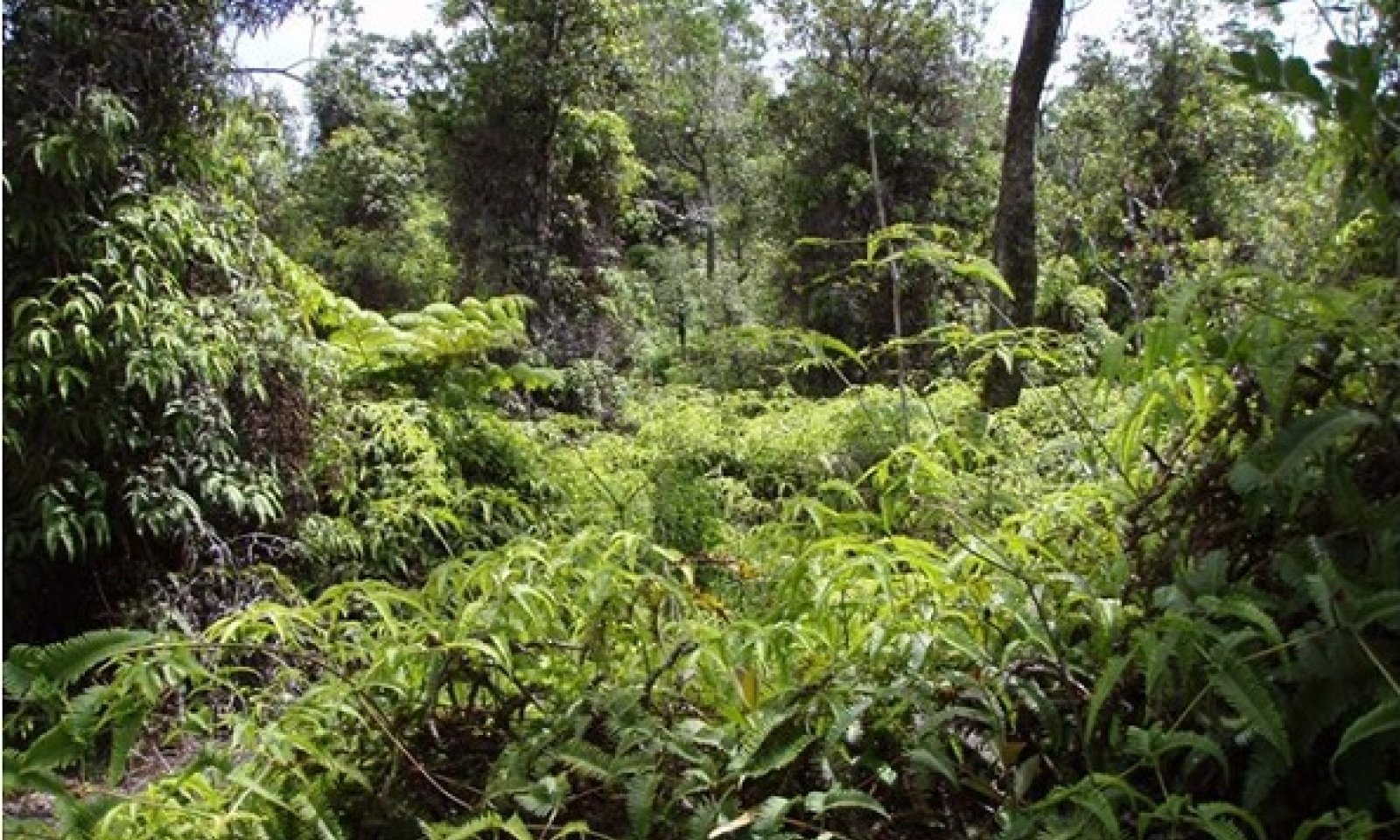

Natural Resources
Conservation Service
Ecological site VX159A01X504
Moderately Well Drained Perudic Forest
Last updated: 11/05/2018
Accessed: 04/02/2025
General information
Provisional. A provisional ecological site description has undergone quality control and quality assurance review. It contains a working state and transition model and enough information to identify the ecological site.

Figure 1. Mapped extent
Areas shown in blue indicate the maximum mapped extent of this ecological site. Other ecological sites likely occur within the highlighted areas. It is also possible for this ecological site to occur outside of highlighted areas if detailed soil survey has not been completed or recently updated.
MLRA notes
Major Land Resource Area (MLRA): 159A–Humid and Very Humid Volcanic Ash Soils on Low and Intermediate Rolling Mountain Slopes
This MLRA occurs in the State of Hawaii on the windward, wetter sides of the islands of Hawaii and Maui. Elevation ranges from near sea level to 6,000 feet (about 2000 meters). Topography is rolling mountain slopes that have been eroded by steep-sided gulches. In most of the area, volcanic ash is underlain by basic igneous rocks, although in some areas volcanic ash was deposited over cinders. Average annual precipitation in most of the area ranges from 120 to 200 inches (3000 to 5000 millimeters); extremes range from 70 inches to 300 inches (1750 to 7500 millimeters). Rainfall is well-distributed throughout the year with an enhanced rainy season from November through April. Average annual air temperatures range from 54 to 73 degrees F (12 to 23 degrees C) with little seasonal variation. The dominant soil order is Andisols with an isothermic or isohyperthermic soil temperature regime and udic or perudic soil moisture regime. Native vegetation consists of medium to tall statured rain forest and open bogs.
Classification relationships
This ecological site occurs within Major Land Resource Area (MLRA) 159A - Humid and Very Humid Volcanic Ash Soils on Low and Intermediate Rolling Mountain Slopes.
Ecological site concept
This ecological site is medium stature, very wet forest that exists in limited areas of windward Mauna Kea. It is mostly found within State Forest Reserves, with minor examples existing on private land. No public roads provide direct access to it.
The central concept of the Isothermic Perudic Forest is of moderately well drained, deep to very deep Andisols formed in deposits of volcanic ash ranging from 100,000 to 300,000 years old. Annual temperatures are warm and rainfall is very high year-round, creating warm (isothermic), wet (perudic), and very strongly acidic soils with some massive soil horizons created by illuvial accumulation of organic matter and sesquioxides (iron and aluminum oxides). The high rainfall and massive horizons create zones of low soil oxygen and water saturation near the surface that reduce root penetration and metabolism. These conditions result in reduced stature of plant species that typically grow much taller under more favorable conditions. Common native plant species are ohia lehua (Metrosideros polymorpha), koa (Acacia koa), hapuu (Cibotium glaucum) in the overstory, and uluhe fern (Dicranopteris linearis) growing in thickets made possible by light coming through the open overstory canopy.
Associated sites
| VX159A01X500 |
Well Drained Udic and Perudic Forest F159AY504 is associated with F159AY500 Deep and Very Deep Volcanic Ash Forest. The two ecological sites co-occur within some soil map units but on different soils within the map units. F159AY500 surrounds F159AY504 on all sides. F159AY500 receives less rainfall and has better drained soils that produce a taller, more diverse forest. |
|---|---|
| VX159A01X009 |
Isothermic Aquic Bog F159AY504 is associated with R159AY009 Isothermic Aquic Bog, the occurrences of which are surrounded by F159AY504. R159AY009 has aquic soil conditions that produce open bogs with vegetation dominated by grasses and sedges. |
Table 1. Dominant plant species
| Tree |
(1) Metrosideros polymorpha |
|---|---|
| Shrub |
Not specified |
| Herbaceous |
(1) Dicranopteris linearis |
Legacy ID
F159AY504HI
Physiographic features
This ecological site occurs on ash fields on sloping mountainsides of shield volcanoes. Volcanic ash fields range from deep to very deep on the underlying lava, which can be pahoehoe or aa.
Table 2. Representative physiographic features
| Landforms |
(1)
Lava flow
(2) Volcano |
|---|---|
| Flooding duration | Very brief (4 to 48 hours) |
| Flooding frequency | None |
| Ponding duration | Very brief (4 to 48 hours) |
| Ponding frequency | Rare to frequent |
| Elevation | 335 – 1,615 m |
| Slope | 2 – 10% |
| Ponding depth | 3 – 15 cm |
| Water table depth | 25 – 76 cm |
| Aspect | E |
Climatic features
Air temperature in Hawaii is buffered by the surrounding ocean so that the range in temperature through the year is narrow. This creates “iso-“soil temperature regimes in which mean summer and winter temperatures differ by less than 6 degrees C (11 degrees F).
Hawaii lies within the trade wind zone. Significant amounts of moisture are picked up from the ocean by trade winds up to an altitude of more than 6000 feet (very roughly 2000 meters). As the trade winds from the northeast are forced up the mountains of the island their moisture condenses, creating rain on the windward slopes; the leeward side of the island receives little of this moisture. At approximately 6000 feet elevation there is a temperature inversion at the boundary between moist air and higher, drier air. Above the inversion layer, average annual temperatures decrease at a slower rate than below it and average annual precipitation decreases abruptly. Easily observed vegetation changes occur within a short distance at the inversion layer.
On the windward side of the island, cool, moist air at higher elevations descends toward the ocean where it meets the trade winds; this process brings night-time rainfall to lower elevation areas.
In winter, low pressure systems often approach the island from the west, producing extensive rainstorms that primarily affect the leeward sides of the island.
Reference: Giambelluca and Schroeder 1998.
In this ecological site, average annual precipitation ranges from 100 to 300 inches (2500 to 7500 millimeters). Rainfall is well-distributed throughout the year with an enhanced rainy season from November through April, with March and April being the wettest months. Average annual air temperature ranges from 59 to 69 degrees F (15 to 21 degrees C). In a typical year, temperature and moisture allow plant growth in all seasons.
Table 3. Representative climatic features
| Frost-free period (average) | 365 days |
|---|---|
| Freeze-free period (average) | 365 days |
| Precipitation total (average) | 6,096 mm |
Figure 2. Monthly precipitation range
Figure 3. Monthly average minimum and maximum temperature
Figure 4. Annual precipitation pattern
Figure 5. Annual average temperature pattern
Climate stations used
-
(1) GLENWOOD NO. 2 55.4 [USC00510746], Volcano, HI
Influencing water features
This ecological site is dissected by numerous, steep sided streams.
This ecological site is complexed with Ecological Site R159AY009 Isothermic Aquic Bog, which occurs on Onomea soils.
Soil features
This ecological site occurs only on Akaka highly organic silty clay loam. Akaka formed in basaltic ash that varies relatively little in chemical composition (Hazlett and Hyndman 1996; Vitousek 2004)). It is classified in the Andisols soil order. Andisols have these general management characteristics: ion exchange capacity that varies with pH, but mostly retaining anions such as nitrate; high phosphorus adsorption, which restricts phosphorus availability to plants; excellent physical properties (low bulk density, good friability, weak stickiness, stable soil aggregates) for cultivation, seedling emergence, and plant root growth; resistance to compaction and an ability to recover from compaction following repeated cycles of wetting and drying; and high capacity to hold water that is available to plants. These characteristics are due to the properties of the parent material, the clay-size noncrystalline materials formed by weathering, and the soil organic matter accumulated during soil formation (Shoji et al. 1993).
The soil moisture regime is perudic, which is defined as a soil moisture regime in climates where precipitation exceeds evapotranspiration in all months of normal years, the moisture tension rarely reaches 100 kPa in the soil moisture control section, although there are occasional brief periods when stored moisture is used, and water moves through the soil in all months when it is not frozen (this soil is never frozen).
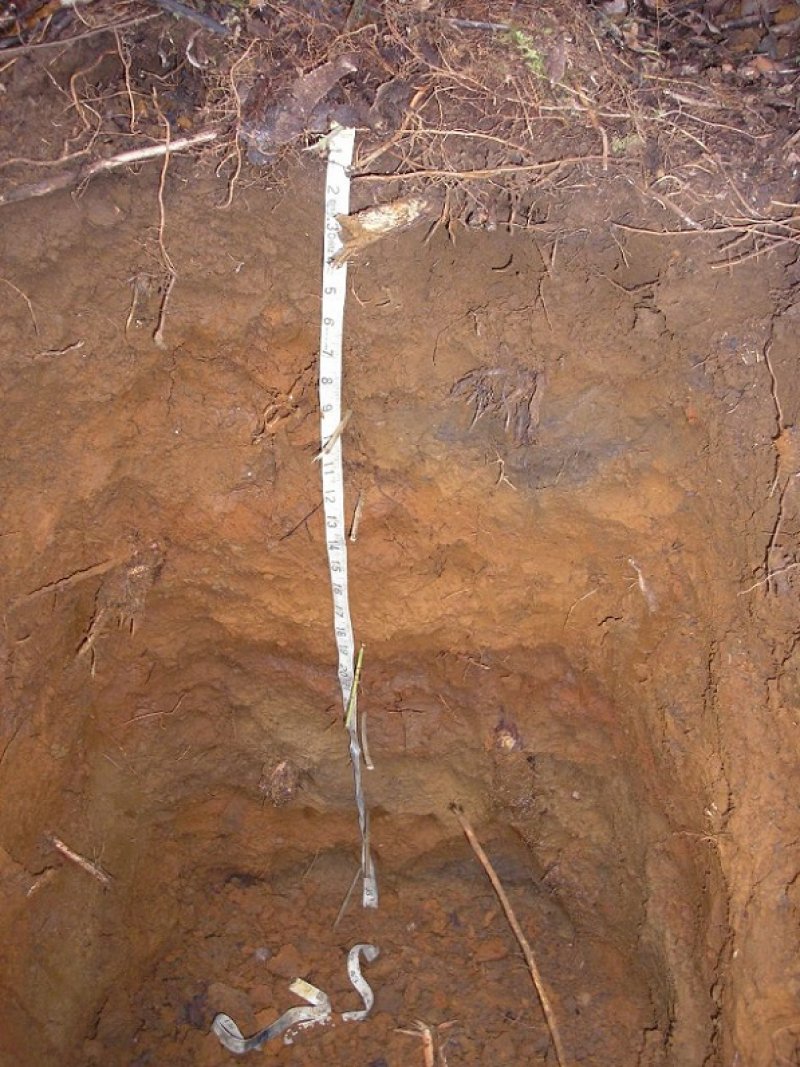
Figure 6. Akaka soil.
Table 4. Representative soil features
| Parent material |
(1)
Basaltic volcanic ash
–
basalt
|
|---|---|
| Surface texture |
(1) Hydrous silty clay loam |
| Drainage class | Moderately well drained |
| Permeability class | Moderately slow |
| Soil depth | 102 – 152 cm |
| Surface fragment cover <=3" | 0% |
| Surface fragment cover >3" | 0% |
| Available water capacity (0-101.6cm) |
35.56 – 38.1 cm |
| Calcium carbonate equivalent (0-101.6cm) |
0% |
| Electrical conductivity (0-101.6cm) |
0 – 2 mmhos/cm |
| Sodium adsorption ratio (0-101.6cm) |
0 |
| Soil reaction (1:1 water) (0-101.6cm) |
4.5 – 5.3 |
| Subsurface fragment volume <=3" (Depth not specified) |
5 – 15% |
| Subsurface fragment volume >3" (Depth not specified) |
0% |
Ecological dynamics
The information in this ecological site description (ESD), including the state-and-transition model (STM), was developed using archaeological and historical data, professional experience, and scientific studies. The information is representative of a complex set of plant communities. Not all scenarios or plants are included. Key indicator plants, animals, and ecological processes are described to inform land management decisions.
States and community phases within this ecological site were differentiated by inspection of data; ordination programs were not available. They were verified by professional consensus and consistent examples in the field.
Human-related disturbances have been much more important than natural disturbances in this ecological site since the arrival of Polynesians and, later, Europeans. This is reflected in the State and Transition Model Diagram.
Humans arrived in the Hawaiian Islands 1200 to 1500 years ago. Their population gradually increased so that by 1600 AD at least 80% of all the lands in Hawaii below about 1500 feet (roughly 500 meters) in elevation had been extensively altered by humans (Kirch 1982)). This ecological site occurs well above that elevation. However, this ecological site affected by factors such as inadvertently introduced plant diseases and seed predation by the introduced Pacific Rat (Athens 1997).
After the arrival of Europeans, documentary evidence attests to accelerated and extensive deforestation, erosion, siltation, and changes in local weather patterns (Kirch 1983) due to more intensive land use, modern tools, and introduction of more plant, animal, and microbe species.
The Polynesians introduced dogs, Pacific rats, and small pigs to the islands. Cattle, sheep, horses, goats, and larger European pigs were introduced in the final decades of the 18th century. These animals ranged free on the islands, becoming very numerous and destructive by the early decades of the 19th century (Henke 1929). The most destructive introduced animals in this relatively remote ecological site have been feral pigs and cattle.
Most of the forest clearing and human disturbance that has occurred has been on F159AY500 Isothermic Udic Forest, which lies at lower elevations than this ecological site. Some areas at the lower boundaries of this ecological site have been affected by harvesting of firewood and intrusion of wildfires from the sugar lands into the forest.
Through the 20th and into the 21st centuries, increases in human populations with attendant land development, as well as accelerated introduction of non-native mammals, birds, reptiles, amphibians, invertebrates, plants, and microorganisms, have brought about dramatic changes to wild ecosystems in Hawaii. Most of the original forest area of this ecological site remains fairly intact. However, the native plant community in many areas has been highly disturbed and in some places destroyed due to clearing, domestic and feral ungulate foraging, and invasion by introduced species. Introduced plant species are capable of completely and permanently replacing native forest.
This ecological site occurs in warm, very wet regions in the northeastern part of the Island of Hawaii, in the South Hilo and North Hilo Districts. Native plant communities evolved without the presence of large mammals. The lava rock underlying the soils ranges from 100,000 to 300,000 years old, so disturbance by lava flows has not occurred for millennia. No recent, heavy volcanic ash falls are in evidence, and vog (acidic aerosols formed in the atmosphere from volcanic gases) has probably not been an important factor on this part of the island in recent times. Wildfires probably are nonexistent due to the wet climate. Blowdown of trees by storms is apparently infrequent due to the deep soils and short to medium stature of the current vegetation.
A large part of this forest is still intact, although some lower elevation areas have been cleared and grazed by domestic cattle. Small patches of the moderately well drained Akaka soils of this ecological site occur below the current forest line within grasslands that have been established on otherwise well-drained soils within Ecological Site F159AY500 Isothermic Udic Forest. These patches of Akaka soils are very susceptible to trampling damage by livestock and are typically dominated by sedges and low-value pasture grasses. Foraging by feral cattle and foraging and digging by feral pigs occurs throughout this ecological site. Rooting by pigs can be severe due to the very low rock content of the soils.
Introduced weeds occur in much of the ecological site; they appear able to invade native stands regardless of human or ungulate disturbances, although such disturbances accelerate their invasion. Introduced weed invasion is inhibited, but not entirely prevented, by the typically dense stands of native uluhe or Old World forkedfern (Dicranopteris linearis) in this ecological site. The major forest weeds are strawberry guava or waiawi (Psidium cattleianum), melastomes, and introduced grasses. Gradual development of stands of strawberry guava creates shady conditions that reduce the density of uluhe and eventually eliminate it.
This ecological site is often intimately complexed on the landscape with two other ecological sites and their associated soils. Onomea soils support bog vegetation consisting primarily of grasses, rushes, and sedges (see Ecological Site R159AY009 Isothermic Aquic Bog). Vegetation similar to that of Isothermic Perudic Forest can grow on dead logs sitting on the bog surface. The transition from bog vegetation on aquic Onomea soils to Isothermic Perudic Forest is typically abrupt, occurring with slight changes in micro-elevation and drainage. Kaiwiki soils support tall, diverse forest (F159AY500HI Isothermic Udic Forest) on still higher micro-elevations and steeper slopes. In many areas, the underlying landscape consists of a series of ridges and lowlands that support all three of these ecological sites in close proximity.
An interesting observation is the common occurrence of very large (>36 inch dbh) downed logs and old snags within the Isothermic Perudic Forest, indicating the presence of a very different forest type on these sites at some time in the past. Additionally, the aquic Onomea soils of the Isothermic Aquic Bog contain coarse pieces of wood at depth. The gradual formation of drainage-impeding soil horizons containing accumulated humus and precipitated iron compounds provides a reasonable hypothesis for the transformation of tall-stature forest to medium-stature forest to treeless bog (Hodges et al. 1986).
State and transition model

Figure 7. STM F159A504
More interactive model formats are also available.
View Interactive Models
More interactive model formats are also available.
View Interactive Models
Click on state and transition labels to scroll to the respective text
Ecosystem states
State 1 submodel, plant communities
State 2 submodel, plant communities
State 3 submodel, plant communities
State 1
Reference State
The Reference State consists of one plant community. Under a regime of natural disturbances, this community has probably been fairly stable through post-glacial time frames with the exception of hypothesized soil changes discussed in Ecological Dynamics of the Site. State 1 can transition into State 2, Invaded State, by clearing and abandonment or by gradual weed invasion, which is exacerbated by feral ungulates. It will transition into State 3, Naturalized Grassland State, by active clearing by humans or by heavy foraging over time by ungulates.
Community 1.1
`Ohi`a lehua - koa/uluhe

Figure 8. Reference community phase Pepeekeo mauka 7/1/08 D Clausnitzer MU905
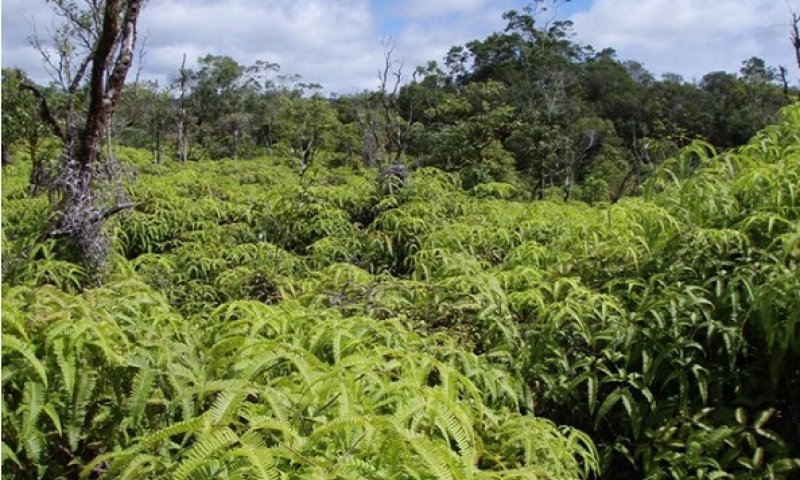
Figure 9. Open canopy area with dense uluhe Pepeekeo mauka 7/1/08 D Clausnitzer MU905
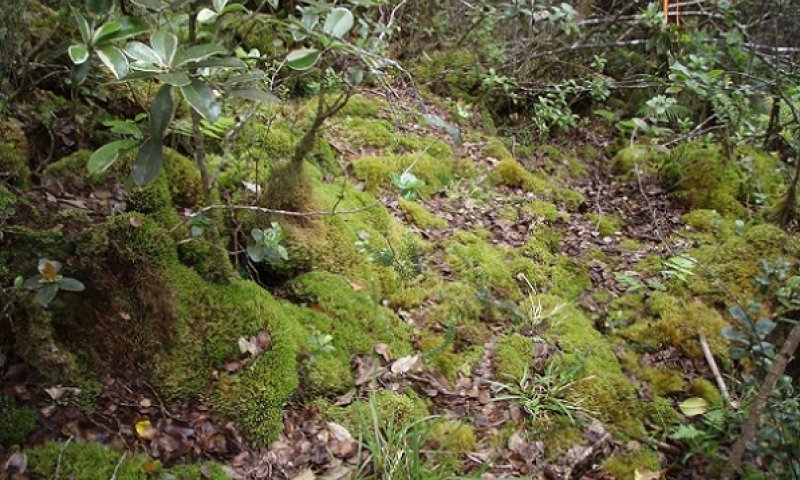
Figure 10. Soil surface cover 8/13/08 D Clausnitzer MU904
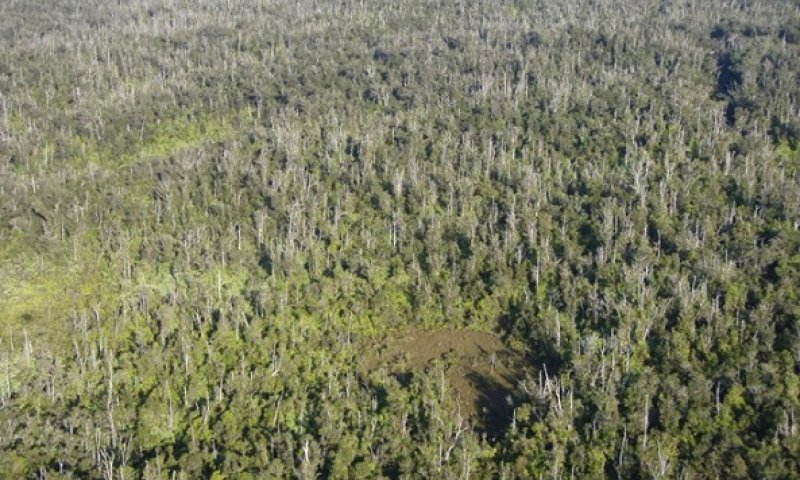
Figure 11. Aerial view 9/15/08 D Clausnitzer
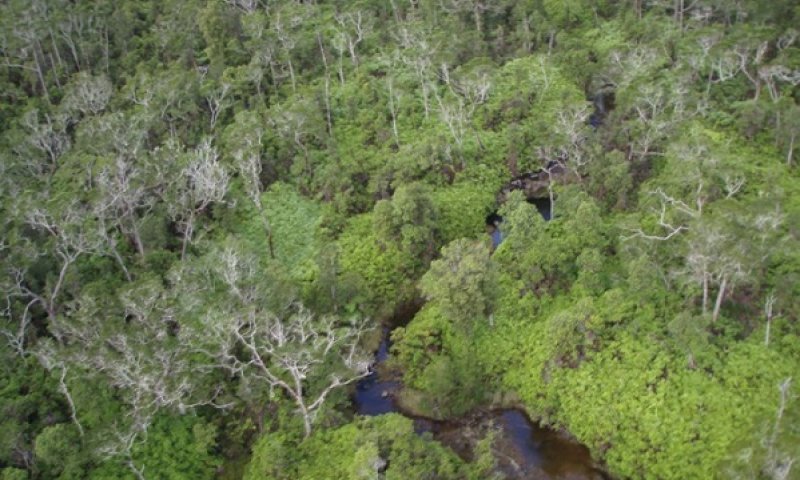
Figure 12. Aerial view with stream 9/15/08 D Clausnitzer
The general appearance is a forest with an open overstory 20 to 30 feet (6 to 9 meters) tall (sometimes taller) and 4 to 10 inches (10 to 25 centimeters) diameter at breast height. Dead snags up to about 60 feet (18 meters) tall and 30 inch (75 centimeters) diameter at breast height are common in many areas. Ohia lehua and koa trees reproduce successfully and occur at a variety of sizes. Scattered trees of other species, typically 10 to 20 feet (3 to 6 meters) tall, as well as shrubs and tree ferns, occur in varying densities. Uluhe fern covers a large percent of the area of this ecological site, both on the ground and climbing upon trees. Uluhe particularly dominates sloping stream banks. These forests have standing live timber of 100 to 500 cubic feet per acre, with a representative value of about 200 cubic feet per acre. Accurate measurement of standing live timber is difficult due to thick layers of moss on tree trunks and difficult accessibility to trees in uluhe thickets.
Forest overstory. The uppermost forest canopy consists of ohi`a lehua or a combination of ohi`a lehua and koa, but canopy cover of `ohi`a lehua is typically somewhat great than that of koa. A scattering of shorter-stature tree species occurs, including kopiko or wild coffee (Psychotria sp.), kolea lau nui (Myrsine lessertiana), and olapa (Cheirodendron trigynum).
Forest understory. The understory contains two species of hapu`u or tree ferns: hapu`u (Cibotium glaucum) and hapu`u `i`i or hapu`u li (Cibotium menziesii). Tree fern density is not great enough to create a continuous canopy. A few additional tree species occur along with some shrubs, vines, forbs, sedges, and grasses. Fern species are diverse but do not account for much canopy cover, except for the thicket-forming uluhe or Old World forkedfern, which creates up to 60% canopy cover.
Table 5. Soil surface cover
| Tree basal cover | 0% |
|---|---|
| Shrub/vine/liana basal cover | 0.0-0.1% |
| Grass/grasslike basal cover | 0.0-0.1% |
| Forb basal cover | 0.0-0.1% |
| Non-vascular plants | 1-5% |
| Biological crusts | 0.0-0.1% |
| Litter | 75-85% |
| Surface fragments >0.25" and <=3" | 0% |
| Surface fragments >3" | 0.0-0.1% |
| Bedrock | 0% |
| Water | 0% |
| Bare ground | 0.1-1.0% |
Table 6. Woody ground cover
| Downed wood, fine-small (<0.40" diameter; 1-hour fuels) | – |
|---|---|
| Downed wood, fine-medium (0.40-0.99" diameter; 10-hour fuels) | – |
| Downed wood, fine-large (1.00-2.99" diameter; 100-hour fuels) | – |
| Downed wood, coarse-small (3.00-8.99" diameter; 1,000-hour fuels) | 0-1% |
| Downed wood, coarse-large (>9.00" diameter; 10,000-hour fuels) | – |
| Tree snags** (hard***) | – |
| Tree snags** (soft***) | – |
| Tree snag count** (hard***) | 2-12 per hectare |
| Tree snag count** (hard***) | 2-25 per hectare |
* Decomposition Classes: N - no or little integration with the soil surface; I - partial to nearly full integration with the soil surface.
** >10.16cm diameter at 1.3716m above ground and >1.8288m height--if less diameter OR height use applicable down wood type; for pinyon and juniper, use 0.3048m above ground.
*** Hard - tree is dead with most or all of bark intact; Soft - most of bark has sloughed off.
Table 7. Canopy structure (% cover)
| Height Above Ground (m) | Tree | Shrub/Vine | Grass/ Grasslike |
Forb |
|---|---|---|---|---|
| <0.15 | 0% | 0% | 0-1% | 0-1% |
| >0.15 <= 0.3 | 0% | 0% | 0-1% | 0-1% |
| >0.3 <= 0.6 | 0-1% | 0-1% | 0-1% | 20-40% |
| >0.6 <= 1.4 | 0-1% | 0-1% | 0-1% | 5-10% |
| >1.4 <= 4 | 3-10% | 0-1% | – | 5-10% |
| >4 <= 12 | 20-25% | – | – | – |
| >12 <= 24 | 0% | – | – | – |
| >24 <= 37 | – | – | – | – |
| >37 | – | – | – | – |
State 2
Invaded State
This state is comprised of one plant community dominated by introduced species in both the overstory and understory. Understory vegetation usually is very sparse to nonexistent. Remnant individuals of a few native species may persist. This state might be considered a dead end as far as further succession or transition to another state. Restoration to a facsimile of the Reference State could probably be done with expensive and intensive practices followed by long-term weed management. This state arises through gradual invasion by introduced species of intact native forest (the Reference State) or by rapid invasion by introduced species of cleared and abandoned sites. Native species are unable to regenerate in the shady, highly competitive stands of introduced plants and eventually die out. Disturbance of the soil and direct damage to native understory plants by introduced ungulates, particularly pigs and cattle, will speed the transition to this state by killing native plants and by creating germination sites for introduced species. Restoration to the Reference State or a facsimile of it is possible by installing pig-proof fence, removing all ungulates, applying herbicides, and replanting native species when needed. Restoration efforts will be affected depending on the degree of invasion by introduced species and by the particular species that have invaded the site. Long term weed management and fence maintenance will be necessary.
Community 2.1
Strawberry guava - `ohi`a lehua/soapbush
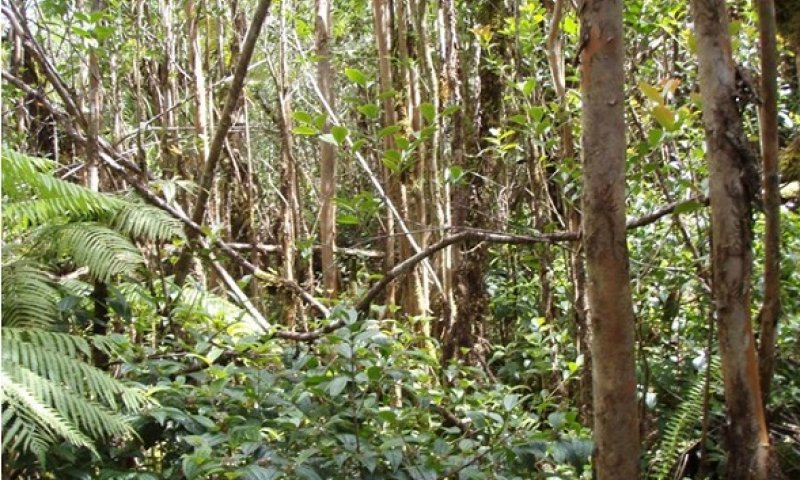
Figure 13. Weed invaded forest 7/1/08 D Clausnitzer MU905
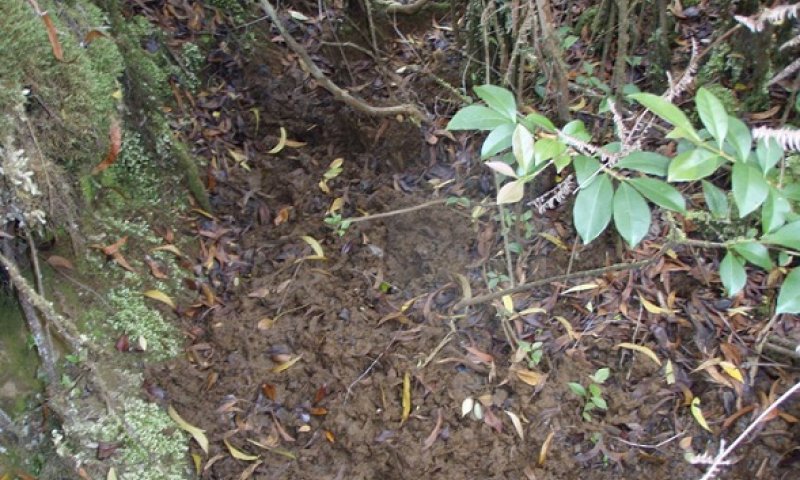
Figure 14. Pig damage to soil surface 7/1/08 D Clausnitzer MU905

Figure 15. Pedestaling caused by soil erosion 7/1/08 D Clausnitzer MU905
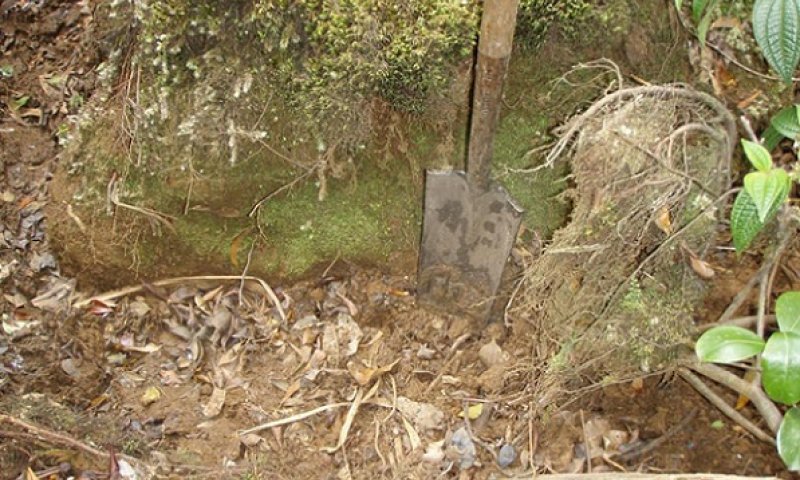
Figure 16. Closeup of erosion-caused pedestal 7/1/08 D Clausnitzer MU 905
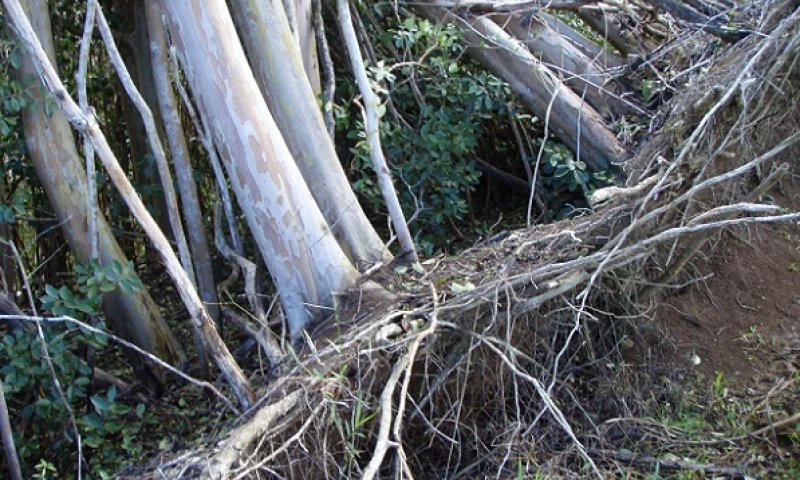
Figure 17. Strawberry guava stand root system D Clausnitzer generic photo
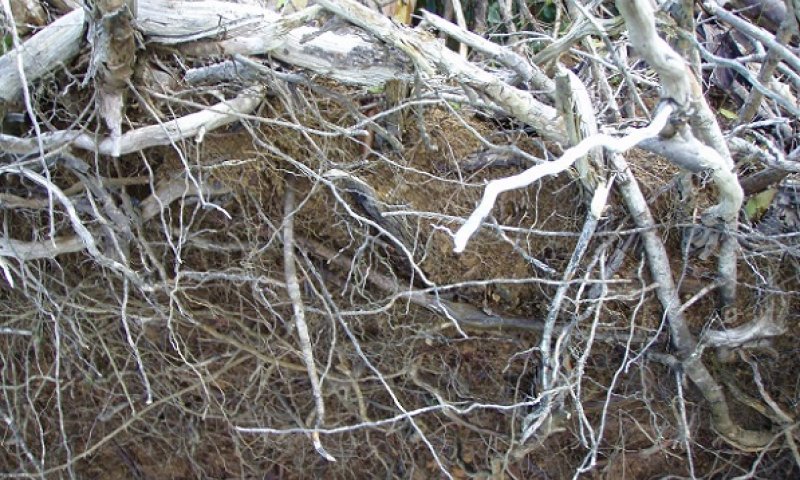
Figure 18. Closeup of strawberry guava roots D Clausnitzer generic photo
This community phase is dominated by introduced species in both the overstory and understory. Strawberry guava is typically the dominant tree species because it invades sites by seeds spread by pigs and reproduces vegetatively by root suckers. Strawberry guava can dominate a site apparently indefinitely because of the dense shade it produces and the competitive advantage conferred by its very dense root system. Strawberry guava can grow and persist under shady canopies. There is almost no understory under dense stands of strawberry guava. Native uluhe fern cover gradually declines as shade increases. Emergent `ohi`a lehua and koa trees may persist in this community for a time along with remnant hapu`u and uluhe ferns. Soil damage by feral pigs creates bare soil areas that are susceptible to erosion by the heavy rains in this ecological site; this apparently leads to the pedestaling of tree roots that is commonly observed
Forest overstory. The tree overstory is often completely dominated by strawberry guava. Scattered individuals of `ohi`a lehua and koa may remain.
Forest understory. The understory beneath strawberry guava is usually very sparse. Some introduced shrubs, ferns, and grasses occur.
The only native species remaining in the lower canopy levels are scattered hapu`u (Cibotium glaucum) and uluhe (Dicranopteris linearis). Some small native fern species may be found, often growing on tree trunks.
Table 8. Soil surface cover
| Tree basal cover | 2-3% |
|---|---|
| Shrub/vine/liana basal cover | 0.0-0.1% |
| Grass/grasslike basal cover | 0.0-0.1% |
| Forb basal cover | 0.0-0.1% |
| Non-vascular plants | 3-5% |
| Biological crusts | 0% |
| Litter | 75-85% |
| Surface fragments >0.25" and <=3" | 0% |
| Surface fragments >3" | 0% |
| Bedrock | 0% |
| Water | 0% |
| Bare ground | 10-25% |
Table 9. Woody ground cover
| Downed wood, fine-small (<0.40" diameter; 1-hour fuels) | – |
|---|---|
| Downed wood, fine-medium (0.40-0.99" diameter; 10-hour fuels) | – |
| Downed wood, fine-large (1.00-2.99" diameter; 100-hour fuels) | – |
| Downed wood, coarse-small (3.00-8.99" diameter; 1,000-hour fuels) | 0-1% |
| Downed wood, coarse-large (>9.00" diameter; 10,000-hour fuels) | 0-2% |
| Tree snags** (hard***) | – |
| Tree snags** (soft***) | – |
| Tree snag count** (hard***) | 2-5 per hectare |
| Tree snag count** (hard***) | 7-12 per hectare |
* Decomposition Classes: N - no or little integration with the soil surface; I - partial to nearly full integration with the soil surface.
** >10.16cm diameter at 1.3716m above ground and >1.8288m height--if less diameter OR height use applicable down wood type; for pinyon and juniper, use 0.3048m above ground.
*** Hard - tree is dead with most or all of bark intact; Soft - most of bark has sloughed off.
Table 10. Canopy structure (% cover)
| Height Above Ground (m) | Tree | Shrub/Vine | Grass/ Grasslike |
Forb |
|---|---|---|---|---|
| <0.15 | 0% | 0% | 0-1% | 0-1% |
| >0.15 <= 0.3 | 0% | 0% | 0-1% | 0-1% |
| >0.3 <= 0.6 | 0% | 0-1% | 0-1% | 5-10% |
| >0.6 <= 1.4 | 3-6% | 3-6% | – | – |
| >1.4 <= 4 | 30-45% | – | – | – |
| >4 <= 12 | 30-50% | – | – | – |
| >12 <= 24 | 0% | – | – | – |
| >24 <= 37 | – | – | – | – |
| >37 | – | – | – | – |
State 3
Naturalized Grassland State
This state is comprised of one community phase consisting of some desirable forage with a preponderance of less desirable species. This state often occurs in patches within ecological site F159AY500 where moderately well drained Akaka soils occur in low spots of map units consisting mostly of well drained soils in grazed areas at lower elevations.
Community 3.1
Manyspike flatsedge - Hilograss
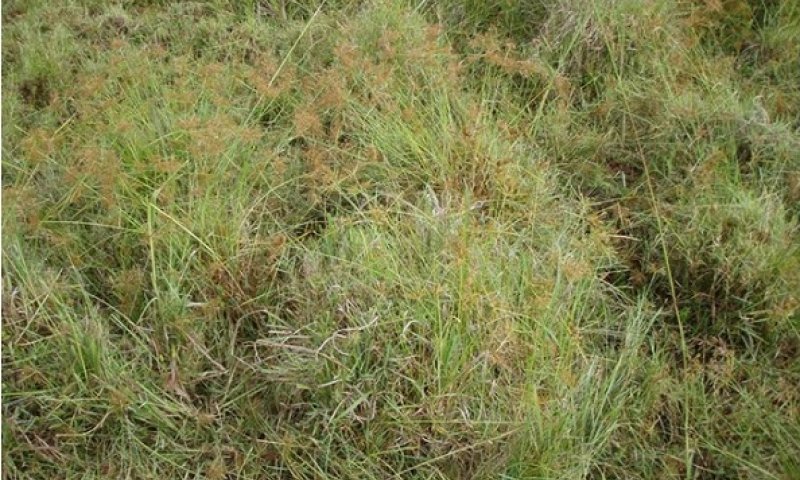
Figure 19. Grassland community phase 7/01/08 D Clausnitzer MU900
Because these grassland occur on patches of wetter soils occurring within areas that are actively grazed by domestic cattle, deep trampling of these sites often occurs. This maintains the sites in a muddy, disturbed condition that makes maintenance of desirable forages difficult.
Forest overstory. This community phase is not forest, despite the automated default heading printed above this section, but rather a naturalized grassland that occurs where forests have been cleared.
The best-managed sites support stands of Californiagrass or para grass (Urochloa mutica). Excessive grazing and/or trampling degrades Californiagrass (aka para grass) stands to stands of lower-statured grasses of lower forage value such as hilograss, Glenwoodgrass, broomsedge, beardgrass, and sedges.
Forest understory. Annual forage production estimates are currently unavailable.
Table 11. Soil surface cover
| Tree basal cover | 0.0-0.1% |
|---|---|
| Shrub/vine/liana basal cover | 0.0-0.1% |
| Grass/grasslike basal cover | 5-10% |
| Forb basal cover | 0.0-0.1% |
| Non-vascular plants | 0% |
| Biological crusts | 0% |
| Litter | 80-90% |
| Surface fragments >0.25" and <=3" | 0% |
| Surface fragments >3" | 0% |
| Bedrock | 0% |
| Water | 0% |
| Bare ground | 10-15% |
Table 12. Canopy structure (% cover)
| Height Above Ground (m) | Tree | Shrub/Vine | Grass/ Grasslike |
Forb |
|---|---|---|---|---|
| <0.15 | – | 0% | 10-20% | 0-1% |
| >0.15 <= 0.3 | – | 0% | 30-40% | 0-1% |
| >0.3 <= 0.6 | – | – | 20-30% | 0% |
| >0.6 <= 1.4 | – | – | 10-25% | – |
| >1.4 <= 4 | – | – | – | – |
| >4 <= 12 | – | – | – | – |
| >12 <= 24 | – | – | – | – |
| >24 <= 37 | – | – | – | – |
| >37 | – | – | – | – |
Transition T1A
State 1 to 2
The Reference state can transition to State 2, Invaded State, by gradual invasion by alien trees, shrubs, and grasses that outcompete native plant species and inhibit their reproduction. This process is accelerated by ungulate foraging that enhances weed germination by disturbance of the soil surface and by directly destroying native plants.
Transition T1B
State 1 to 3
The Reference State can transition to State 3, Naturalized Grassland State, by clearing the forest with heavy machinery and planting or allowing invasion by pasture species. Native forest may be cleared gradually by allowing feral or domestic cattle uncontrolled access to the forest. Cattle eventually eat or destroy understory ferns, forbs, shrubs, and saplings, opening up the forest so that pasture grasses will thrive.
Restoration pathway R2A
State 2 to 1
Restoration to the Reference State may be possible where excessive soil erosion has not occurred. Propagation and/or relocation of uluhe fern to sites from which it has disappeared is difficult. Remnant uluhe should be protected and encouraged to spread. Natural propagation of uluhe on small, mossy logs placed under uluhe stands is possible; these logs can then be relocated to restoration sites. Before restoration of native plants, invasive plants must be eliminated by herbicide weed control and brush management practices. Also, feral and domestic ungulates must be excluded from the restoration site by a fence, and any remaining ungulates within the fenced site must be eliminated. If feral pigs are present, an intensive, short-term program must be employed to eliminate their population; otherwise, their rate of increase will outpace control efforts. Key native plant species that have been eliminated or greatly reduced in numbers generally must be restored by replanting. Long-term maintenance of the site using herbicides, hand-weeding, mulching, and fence repair is required.
Restoration pathway R2B
State 2 to 3
State 2, Invaded State, may be restored to State 3, Naturalized Grassland, by mechanical clearing of overstory and understory vegetation followed by herbicide control of reemerging invasive species. Introduced grasses may then be seeded or sprigged into the site. Herbicide applications, mowing, and careful grazing practices will be necessary during and after pasture establishment to control reemerging weed species.
Restoration pathway R3A
State 3 to 1
It may be possible to restore State 3, Naturalized Grassland State, to a plant community resembling State 1, Reference State, by intensive restoration practices followed by long-term maintenance. Control of grasses and any weeds currently in the grassland by mowing, herbicides, and mulch must precede establishment of native species. Weed control would be a long-term process to maintain the site during and after establishment. Many weeds are shade-tolerant and would be able to invade the site even after establishment of native plants. Domestic and feral ungulates must be fenced out of the restoration site. However, managed grazing by domestic ungulates outside the fence would be useful to manage weedy vegetation outside the perimeter. Reestablishment of uluhe fern thickets would be essential to any restoration attempt. Remnant uluhe must be preserved the site. Uluhe fern is difficult to propagate and relocate to sites from which it is absent. It is possible to naturally propagate uluhe by placing mossed-covered pieces of tree wood beneath uluhe thickets; then move them to the restoration site.
Transition T3A
State 3 to 2
State 3, Naturalized Grassland State, may be converted to State 2, Invaded State, by abandonment. Seeds of strawberry guava as well as those of weedy understory shrubs are spread by mammals and birds.
Additional community tables
Table 13. Community 1.1 forest overstory composition
| Common name | Symbol | Scientific name | Nativity | Height (m) | Canopy cover (%) | Diameter (cm) | Basal area (square m/hectare) |
|---|---|---|---|---|---|---|---|
|
Tree
|
|||||||
| 'ohi'a lehua | MEPO5 | Metrosideros polymorpha | Native | 6.1–10.7 | 5–25 | 12.7–25.4 | – |
| koa | ACKO | Acacia koa | Native | 6.1–10.7 | 1–5 | 12.7–25.4 | – |
| wild coffee | PSYCH | Psychotria | Native | 4–9.1 | 0.1–1 | – | – |
| kolea lau nui | MYLE2 | Myrsine lessertiana | Native | 4–7.6 | 0.1–1 | – | – |
| olapalapa | CHTR2 | Cheirodendron trigynum | Native | 0.6–4 | 0–1 | – | – |
| pritchardia | PRITC | Pritchardia | Native | 6.1–7.6 | 0–1 | – | – |
| olapalapa | CHTR2 | Cheirodendron trigynum | Native | 6.1–9.1 | 0–0.1 | – | – |
Table 14. Community 1.1 forest understory composition
| Common name | Symbol | Scientific name | Nativity | Height (m) | Canopy cover (%) | |
|---|---|---|---|---|---|---|
|
Grass/grass-like (Graminoids)
|
||||||
| twigrush | MACHA2 | Machaerina | Native | 0.9–1.5 | 0.1–1 | |
| sedge | CAREX | Carex | Native | 0.2–0.6 | 0.1–1 | |
| ridgetop bloodgrass | ISDI | Isachne distichophylla | Native | 0.3–0.6 | 0.1–1 | |
| Hawai'i sedge | CAAL12 | Carex alligata | Native | 0.6–1.2 | 0–0.1 | |
|
Forb/Herb
|
||||||
| pua'akuhinia | ASME4 | Astelia menziesiana | Native | 0.3–0.6 | 0.1–1 | |
| alpine woodfern | DRWA | Dryopteris wallichiana | Native | 0.3–0.6 | 0.1–1 | |
| peperomia | PEPER | Peperomia | Native | 0.2–0.3 | 0.1–1 | |
| korthal mistletoe | KORTH | Korthalsella | Native | 0.3–0.6 | 0–0.1 | |
|
Fern/fern ally
|
||||||
| Old World forkedfern | DILI | Dicranopteris linearis | Native | 0.9–2.4 | 30–80 | |
| wahini noho mauna | ADTA | Adenophorus tamariscinus | Native | 0.2–0.3 | 0.1–1 | |
| royal tonguefern | ELCR2 | Elaphoglossum crassifolium | Native | 0.2–0.3 | 0.1–1 | |
| ekaha | ELHI3 | Elaphoglossum hirtum | Native | 0.2–0.3 | 0.1–1 | |
| kolokolo | GRTE | Grammitis tenella | Native | 0.2–0.3 | 0.1–1 | |
| spleenwort | ASPLE | Asplenium | Native | 0.3–0.6 | 0.1–1 | |
| ohiaku | HYRE | Hymenophyllum recurvum | Native | 0.2–0.3 | 0.1–1 | |
| vandenboschia | VANDE | Vandenboschia | Native | 0.2–0.3 | 0.1–1 | |
| Old World adderstongue | OPPEP | Ophioglossum pendulum ssp. pendulum | Native | 0.2–0.3 | 0.1–1 | |
| sadleria | SADLE | Sadleria | Native | 0.3–1.2 | 0.1–1 | |
| Hawai'i umbrella fern | STOW | Sticherus owhyensis | Native | 0.3–0.6 | 0.1–1 | |
| scrambling fern | DIPI3 | Diplopterygium pinnatum | Native | 0.3–1.8 | 0.1–1 | |
| weeping fern | LETH6 | Lepisorus thunbergianus | Native | 0.2–0.3 | 0.1–1 | |
| whisk fern | PSNU | Psilotum nudum | Native | 0.2–0.3 | 0.1–1 | |
| flatfork fern | PSCO3 | Psilotum complanatum | Native | 0.2–0.3 | 0.1–1 | |
| Chinese creepingfern | ODCH | Odontosoria chinensis | Native | 0.3–0.6 | 0–0.1 | |
| akolea | ATMI | Athyrium microphyllum | Native | 0.3–0.6 | 0–0.1 | |
| clubmoss | HUPER | Huperzia | Native | 0.2–0.3 | 0–0.1 | |
| graceful kihifern | ADPI | Adenophorus pinnatifidus | Native | 0.2–0.3 | 0–0.1 | |
|
Shrub/Subshrub
|
||||||
| clermontia | CLERM | Clermontia | Native | 0.6–1.8 | 0.1–1 | |
| ohelo kau la'au | VACA8 | Vaccinium calycinum | Native | 0.6–1.5 | 0.1–1 | |
| pukiawe | STTA | Styphelia tameiameiae | Native | 0.6–1.5 | 0–0.1 | |
| kanawao | BRAR6 | Broussaisia arguta | Native | 0.6–1.2 | 0–0.1 | |
|
Tree
|
||||||
| kokea lau li'i | MYSA2 | Myrsine sandwicensis | Native | 1.2–4 | 0.1–1 | |
| ha'a | ANPL2 | Antidesma platyphyllum | Native | 1.2–3 | 0.1–1 | |
| variable starviolet | HETE21 | Hedyotis terminalis | Native | 1.2–3 | 0.1–1 | |
| Hawai'i holly | ILAN | Ilex anomala | Native | 1.8–3 | 0.1–1 | |
| 'ohi'a lehua | MEPO5 | Metrosideros polymorpha | Native | 0.6–4 | 0.1–1 | |
| koa | ACKO | Acacia koa | Native | 0.6–4 | 0–0.1 | |
|
Tree Fern
|
||||||
| hapu'u | CIGL | Cibotium glaucum | Native | 1.5–4 | 1–5 | |
| hapu'u li | CIME8 | Cibotium menziesii | Native | 1.5–4 | 0.1–1 | |
|
Vine/Liana
|
||||||
| 'ie'ie | FRAR | Freycinetia arborea | Native | 0.3–6.1 | 0.1–1 | |
| Hawai'i greenbrier | SMME | Smilax melastomifolia | Native | 0.3–3 | 0–0.1 | |
Table 15. Community 2.1 forest overstory composition
| Common name | Symbol | Scientific name | Nativity | Height (m) | Canopy cover (%) | Diameter (cm) | Basal area (square m/hectare) |
|---|---|---|---|---|---|---|---|
|
Tree
|
|||||||
| strawberry guava | PSCA | Psidium cattleianum | Introduced | 4.6–7.6 | 20–45 | – | – |
| strawberry guava | PSCA | Psidium cattleianum | Introduced | 0.9–4 | 30–40 | – | – |
| 'ohi'a lehua | MEPO5 | Metrosideros polymorpha | Native | 4.6–7.6 | 3–5 | – | – |
| koa | ACKO | Acacia koa | Native | 6.1–9.1 | 0.1–1 | – | – |
| koa | ACKO | Acacia koa | Native | 9.1–12.2 | 0–0.1 | – | – |
| 'ohi'a lehua | MEPO5 | Metrosideros polymorpha | Native | 9.1–12.2 | 0–0.1 | – | – |
Table 16. Community 2.1 forest understory composition
| Common name | Symbol | Scientific name | Nativity | Height (m) | Canopy cover (%) | |
|---|---|---|---|---|---|---|
|
Grass/grass-like (Graminoids)
|
||||||
| common carpetgrass | AXFI | Axonopus fissifolius | Introduced | 0.2–0.3 | 0.1–1 | |
| glenwoodgrass | SAIN | Sacciolepis indica | Introduced | 0.2–0.3 | 0.1–1 | |
|
Forb/Herb
|
||||||
| Colombian waxweed | CUCA4 | Cuphea carthagenensis | Introduced | 0.2–0.3 | 0.1–1 | |
|
Fern/fern ally
|
||||||
| Old World forkedfern | DILI | Dicranopteris linearis | Native | 0.3–0.6 | 5–10 | |
| wahini noho mauna | ADTA | Adenophorus tamariscinus | Native | 0.2–0.3 | 0.1–1 | |
| ohiaku | HYRE | Hymenophyllum recurvum | Native | – | 0.1–1 | |
| royal tonguefern | ELCR2 | Elaphoglossum crassifolium | Native | 0.2–0.3 | 0.1–1 | |
| Asian swordfern | NEMU | Nephrolepis multiflora | Introduced | 0.3–0.6 | 0.1–1 | |
| golden polypody | PHAU6 | Phlebodium aureum | Introduced | 0.3–0.6 | 0.1–1 | |
| Chinese creepingfern | ODCH | Odontosoria chinensis | Native | 0.3–0.6 | 0–0.1 | |
| Cretan brake | PTCR2 | Pteris cretica | Native | – | 0–0.1 | |
| Oriental vessel fern | ANEV | Angiopteris evecta | Introduced | 0.6–1.8 | – | |
|
Shrub/Subshrub
|
||||||
| soapbush | CLHI3 | Clidemia hirta | Introduced | 0.6–1.2 | 1–5 | |
| herbaceous glorytree | TIHE2 | Tibouchina herbacea | Introduced | 0.9–1.5 | 0.1–1 | |
|
Tree Fern
|
||||||
| hapu'u | CIGL | Cibotium glaucum | Native | 1.5–3.7 | 0.1–1 | |
| hapu'u li | CIME8 | Cibotium menziesii | Native | 1.5–3.7 | 0.1–1 | |
|
Vine/Liana
|
||||||
| West Indian raspberry | RURO | Rubus rosifolius | Introduced | 0.6–1.2 | 0.1–1 | |
Table 17. Community 3.1 forest understory composition
| Common name | Symbol | Scientific name | Nativity | Height (m) | Canopy cover (%) | |
|---|---|---|---|---|---|---|
|
Grass/grass-like (Graminoids)
|
||||||
| hilograss | PACO14 | Paspalum conjugatum | Introduced | 0.2–0.3 | 20–50 | |
| manyspike flatsedge | CYPO | Cyperus polystachyos | Native | 0.2–0.3 | 30–40 | |
| para grass | URMU | Urochloa mutica | Introduced | 0.3–0.6 | 10–30 | |
| broomsedge bluestem | ANVI2 | Andropogon virginicus | Introduced | 0.6–1.2 | 10–30 | |
| Colombian bluestem | SCCO10 | Schizachyrium condensatum | Introduced | 0.6–1.2 | 10–20 | |
| smut grass | SPIN4 | Sporobolus indicus | Introduced | 0.2–0.3 | 5–10 | |
| glenwoodgrass | SAIN | Sacciolepis indica | Introduced | 0.2–0.3 | 1–2 | |
| Vasey's grass | PAUR2 | Paspalum urvillei | Introduced | 0.3–0.6 | 1–2 | |
|
Forb/Herb
|
||||||
| climbing dayflower | CODI5 | Commelina diffusa | Introduced | 0.2–0.3 | 0.1–1 | |
| shameplant | MIPU8 | Mimosa pudica | Introduced | 0.2–0.3 | 0.1–1 | |
| Colombian waxweed | CUCA4 | Cuphea carthagenensis | Introduced | 0.2–0.3 | 0.1–1 | |
Interpretations
Animal community
Native Wildlife
This ecological site provides habitat to the following native birds: elepaio (Chasiempis sandwichensis), amakihi (Hemignathus virens), apapane (Himatione sanguinea), iiwi (Vestiaria coccinea), omao (Myadestes obscurus), Hawaiian crow or alala (Corvus hawaiensis), akepa (Loxops coccineus), and akiapolaau (Hemignathus wilsoni). It also is home to the Hawaiian hoary bat or opeapea (Lasiurus cenarius semotus). These species may be encountered within all community phases but are most prevalent in open canopy native forest and forest adjacent to clearings. Community phases that provide open grassland or savannah-like settings provide habitat for the native Hawaiian hawk, or io (Buteo solitarius) and Hawaiian owl or pueo (Asio flammeus spp. sandwichensis).
A large number of native bird species have gone extinct both before and after European contact.
Introduced Wildlife
This ecological site provides habitat to a variety of introduced birds. Species such as wild turkey (Meleagris gallopavo), ring-necked pheasant (Phasianus colchicus), Erckel’s francolin (Pternistis erckelii), black francolin (Francolinus francolinus), and kalij pheasant (Lophura leucomelanos) are considered to be game birds.
Feral pigs and cattle are common. They provide hunting opportunities but are very destructive to native vegetation. Public sport hunting typically does not have a major impact on their populations, especially in the remote, inaccessible areas that constitute much of this ecological site.
Introduced wildlife species are able to utilize all community phases within the ecological site.
Hydrological functions
This ecological site occurs on footslopes and toeslopes; slopes range from 0 to 10%. Permeability of the soils is moderately slow. Under the frequently rainy conditions of the prevailing climate, runoff can be high. This runoff goes into the many streams occurring in this ecological site or into the interspersed bogs of R159AY009 Mauna Kea bog.
Soil erosion is not severe except where feral pigs have created bare ground and excavations leading to channeled runoff and eventual pedestaling of trees and shrubs.
Recreational uses
Hunting, hiking, and bird watching are possible in this ecological site. However, much of the area is fairly inaccessible to vehicles, and foot access is made difficult by dense stands of uluhe fern.
Wood products
No wood products are harvested from this ecological site.
Other products
None.
Other information
Definitions
These definitions have been greatly simplified for brevity and do not cover every aspect of each topic.
Aa lava: A type of basaltic lava having a rough, jagged, clinkery surface and a vesicular interior.
Alluvial: Materials or processes associated with transportation and/or deposition by running water.
Aquic soil moisture regime: A regime in which the soil is free of dissolved oxygen because it is saturated by water. This regime typically exists in bogs or swamps.
Aridic soil moisture regime: A regime in which defined parts of the soil are, in normal years, dry for more than half of the growing season and moist for less than 90 consecutive days during the growing season. In Hawaii it is associated with hot, dry areas with plants such as kiawe, wiliwili, and buffelgrass. The terms aridic and torric are basically the same.
Ash field: a land area covered by a thick or distinctive deposit of volcanic ash that can be traced to a specific source and has well defined boundaries. The term “ash flow” is erroneously used in the Physiographic section of this ESD due to a flaw in the national database.
Ashy: A “soil texture modifier” for volcanic ash soils having a water content at the crop wilting point of less than 30 percent; a soil that holds relatively less water than “medial” and “hydrous” soils.
Available water capacity: The amount of soil water available to plants to the depth of the first root-restricting layer.
Basal area or basal cover: The cross sectional area of the stem or stems of a plant or of all plants in a stand.
Blue rock: The dense, hard, massive lava that forms the inner core of an aa lava flow.
Bulk density: the weight of dry soil per unit of volume. Lower bulk density indicates a greater amount of pore space that can hold water and air in a soil.
CaCO3 equivalent: The amount of free lime in a soil. Free lime exists as solid material and typically occurs in regions with a dry climate.
Canopy cover: The percentage of ground covered by the vertical projection downward of the outermost perimeter of the spread of plant foliage. Small openings within the canopy are included.
Community pathway: A description of the causes of shifts between community phases. A community pathway is reversible and is attributable to succession, natural disturbances, short-term climatic variation, and facilitating practices, such as grazing management.
Community phase: A unique assemblage of plants and associated dynamic soil properties within a state.
Dominant species: Plant species or species groups that exert considerable influence upon a community due to size, abundance, or cover.
Drainage class: The frequency and duration of a water table in a soil. There are seven drainage classes, ranging from “excessively drained” (soils with very rare or very deep water tables) to “well drained” (soils that provide ample water for plant growth but are not so wet as to inhibit root growth) to “very poorly drained” (soils with a water table at or near the surface during much of the growing season that inhibits growth of most plants).
Electrical conductivity (EC): A measure of the salinity of a soil. The standard unit is deciSiemens per meter (dS/m), which is numerically equivalent to millimhos per centimeter (mmhos/cm). An EC greater than about 4 dS/m indicates a salinity level that is unfavorable to growth of most plants.
Friability: A soil consistency term pertaining to the ease of crumbling of soils.
Hydrous: A “soil texture modifier” for volcanic ash soils having a water content at the crop wilting point of 100 percent or more; a soil that holds more water than “medial” or “ashy” soils.
Ion exchange capacity: The ability of soil materials such as clay or organic matter to retain ions (which may be plant nutrients) and to release those ions for uptake by roots.
Isohyperthermic soil temperature regime: A regime in which mean annual soil temperature is 72 degrees F (22 degrees C) or higher and mean summer and mean winter soil temperatures differ by less than 11 degrees F (6 degrees C) at a specified depth.
Isomesic soil temperature regime: A regime in which mean annual soil temperature is 47 degrees F (8 degrees C) or higher but lower than 59 degrees F (15 degrees C) and mean summer and mean winter soil temperatures differ by less than 11 degrees F (6 degrees C) at a specified depth.
Isothermic soil temperature regime: A regime in which mean annual soil temperature is 59 degrees F (15 degrees C) or higher but lower than 72 degrees F (22 degrees C) and mean summer and mean winter soil temperatures differ by less than 11 degrees F (6 degrees C) at a specified depth.
Kipuka: An area of land surrounded by younger (more recent) lava. Soils and plant communities within a kipuka are older than, and often quite different from, those on the surrounding surfaces.
Major Land Resource Area (MLRA): A geographic area defined by NRCS that is characterized by a particular pattern of soils, climate, water resources, and land uses. The island of Hawaii contains nine MLRAs, some of which also occur on other islands in the state.
Makai: a Hawaiian word meaning “toward the sea.”
Mauka: a Hawaiian word meaning “toward the mountain” or “inland.”
Medial: A “soil texture modifier” for volcanic ash soils having a water content at the crop wilting point of 30 to 100 percent; a soil that holds an amount of water intermediate to “hydrous” or “ashy” soils.
Naturalized plant community: A community dominated by adapted, introduced species. It is a relatively stable community resulting from secondary succession after disturbance. Most grasslands in Hawaii are in this category.
Pahoehoe lava: A type of basaltic lava with a smooth, billowy, or rope-like surface and vesicular interior.
Parent material: Unconsolidated and chemically weathered material from which a soil is developed.
Perudic soil moisture regime: A very wet regime found where precipitation exceeds evapotranspiration in all months of normal years. On the island of Hawaii, this regime is found on top of Kohala and on parts of the windward side of Mauna Kea.
pH: The numerical expression of the relative acidity or alkalinity of a soil sample. A pH of 7 is neutral; a pH below 7 is acidic and a pH above 7 is basic.
Phosphorus adsorption: The ability of soil materials to tightly retain phosphorous ions, which are a plant nutrient. Some volcanic ash soils retain phosphorus so strongly that it is partly unavailable to plants.
Reference community phase: The phase exhibiting the characteristics of the reference state and containing the full complement of plant species that historically occupied the site. It is the community phase used to classify an ecological site.
Reference state: A state that describes the ecological potential and natural or historical range of variability of an ecological site.
Restoration pathway: A term describing the environmental conditions and practices that are required to recover a state that has undergone a transition.
Sodium adsorption ratio (SAR): A measure of the amount of dissolved sodium relative to calcium and magnesium in the soil water. SAR values higher than 13 create soil conditions unfavorable to most plants.
Soil moisture regime: A term referring to the presence or absence either of ground water or of water held at a tension of less than 1500 kPa (the crop wilting point) in the soil or in specific horizons during periods of the year.
Soil temperature regime: A defined class based on mean annual soil temperature and on differences between summer and winter temperatures at a specified depth.
Soil reaction: Numerical expression in pH units of the relative acidity or alkalinity or a soil.
State: One or more community phases and their soil properties that interact with the abiotic and biotic environment to produce persistent functional and structural attributes associated with a characteristic range of variability.
State-and-transition model: A method used to display information about relationships between vegetation, soil, animals, hydrology, disturbances, and management actions on an ecological site.
Torric soil moisture regime: See Aridic soil moisture regime.
Transition: A term describing the biotic or abiotic variables or events that contribute to loss of state resilience and result in shifts between states.
Udic soil moisture regime: A regime in which the soil is not dry in any part for as long as 90 cumulative days in normal years, and so provides ample moisture for plants. In Hawaii it is associated with forests in which hapuu (tree ferns) are usually moderately to highly abundant.
Ustic soil moisture regime: A regime in which moisture is limited but present at a time when conditions are suitable for plant growth. In Hawaii it usually is associated with dry forests and subalpine shrublands.
Supporting information
Inventory data references
Type locality
| Location 1: Hawaii County, HI | |
|---|---|
| Latitude | 19° 47′ 48″ |
| Longitude | 155° 9′ 19″ |
| General legal description | From Mamalahoa Hwy take Keeiei Rd to locked gate, go S 0.1 mi to airstrip; go rt along airstrip, go right, take road N/NW for 0.5 mi; go left 0.5 mi; walk W on trail 0.2 mi, go rt (N) at fork; cross stream, go W to coordinates. |
Other references
Armstrong RW. 1973. Atlas of Hawaii. University of Hawaii Press, Honolulu.
Athens JS. Ch. 12 Hawaiian Native Lowland Vegetation in Prehistory in Historical Ecology in the Pacific Islands – Prehistoric Environmental and Landscape Change. Kirch, PV and TL Hunt, eds. 1997. Yale U. Press, New Haven.
Burney, DA, HF James, LP Burney, SL Olson, W Kikuchi, WL Wagner, M Burney, D McCloskey, D Kikuchi, FV Grady, R Gage II, and R Nishek. 2001. Fossil evidence for a diverse biota from Kauai and tis transformation since human arrival. Ecological Monographs 71:615-641.
Craighill ES and EG Handy. 1991. Native Planters in Old Hawaii – Their Life, Lore, and Environment. Bernice P. Bishop Museum Bulletin 233, Bishop Museum Press, Honolulu, HI
Cuddihy LW and CP Stone. 1990. Alteration of Native Hawaiian Vegetation: Effects of Humans, Their Activities and Introductions. Honolulu: University of Hawaii Cooperative National Park Resources Study Unit.
Hazlett RW and DW Hyndman. 1996. Roadside Geology of Hawaii. Mountain Press Publishing Company, Missoula MT.
Henke LA. 1929. A Survey of Livestock in Hawaii. Research Publication No. 5. University of Hawaii, Honolulu.
Hodges CS, KT Adee, JD Stein, HB Wood, and RD Doty . 1986. Decline of Ohia (Metrosideros polymorpha) in Hawaii: a review. USDA-Forest Service, Pacific Southwest Forest and Range Experiment Station, General Technical Report SW-86.
Kirch PV 1982. The impact of the prehistoric Polynesians in the Hawaiian ecosystem. Pacific Science 36(1):1-14.
Kirch PV. 1985. Feathered Gods and Fishhooks: An Introduction to Hawaiian Archaeology and Prehistory. Honolulu: University of Hawaii Press.
Kirch PV. 2000. On the Road of the Winds: An Archaeological History of the Pacific Islands Before European Contact. Berkeley: University of California Press.
Little EL Jr. and RG Skolmen. 1989. Common Forest Trees of Hawaii (Native and Introduced). US Department of Agriculture-US Forest Service Agriculture Handbook No. 679. (out of print). Available at www.fs.fed.us/psw/publications/documents/misc/ah679.pdf
Mueller-Dombois D and FR Fosberg. 1998. Vegetation of the Tropical Pacific Islands. Springer-Verlag New York, Inc.
Palmer DD. 2003. Hawaii’s Ferns and Fern Allies. University of Hawaii Press, Honolulu.
Pratt, H.D. 1998. A Pocket Guide to Hawaii’s Trees and Shrubs. Mutual Publishing, Honolulu.
Rock JF. The Indigenous Trees of the Hawaiian Islands. 1st edition 1913, reprinted 1974, Charles E. Tuttle Company, Rutland, VT and Tokyo, Japan.
Shoji SD, M Nanzyo, and R Dahlgren. 1993. Volcanic Ash Soils: Genesis, Properties and Utilization. Elsevier, New York.
Sohmer SH and R Gustafson. 2000. Plants and Flowers of Hawaii. University of Hawaii Press, Honolulu.
Steadman DW. 1995. Prehistoric extinctions of Pacific island birds: biodiversity meets zooarchaeology. Science 267:1123-1131.
Vitousek P. 2004. Nutrient Cycling and Limitation: Hawaii as a Model Ecosystem. Princeton University Press, Princeton and Oxford.
Wagner WL, DR Herbst, and SH Sohmer. 1999. Manual of the Flowering Plants of Hawaii, Revised Edition. Bishop Museum Press, Honolulu.
Whistler, WA. 1995. Wayside Plants of the Islands: a Guide to the Lowland Flora of the Pacific Islands. Isle Botanica, Honolulu.
Contributors
David Clausnitzer
Loretta Metz
Approval
Kendra Moseley, 11/05/2018
Acknowledgments
Assistance, advice, review, and/or insights:
Mick Castillo
Michael Constantinides, NRCS-PIA
Susan Cordell, USFS
Gordon Cran, Kapapala Ranch
David Leonard, volunteer
JB Friday, UH Forestry Extension
Rick Gordon
Basil Hansen, The Nature Conservancy
Jennifer Higashino, USFWS and NRCS
Flint Hughes, USFS
Chris Jasper, NRCS Soil Survey
Mel Johansen, The Nature Conservancy
Kathy Kawakami, US Army Pohakuloa Training Ground
Rhonda Loh, Volcanoes National Park
Kamehameha Schools/Bishop Estate
Miles Nakahara, Hawaii DOFAW
Laura Nelson, The Nature Conservancy and NRCS
Patrick Niemeyer, NRCS Soil Survey
Billy Paris, rancher
John Pipan
Jon Price, USGS
John Replogle, The Nature Conservancy
Paul Scowcroft, USFS
Earl Spence, grazing consultant
Jim Thain
Mike Tomich
Quentin Tomich
Tim Tunison, Volcanoes National Park
Jill Wagner, consultant, Future Forests
Rick Warschauer
Rangeland health reference sheet
Interpreting Indicators of Rangeland Health is a qualitative assessment protocol used to determine ecosystem condition based on benchmark characteristics described in the Reference Sheet. A suite of 17 (or more) indicators are typically considered in an assessment. The ecological site(s) representative of an assessment location must be known prior to applying the protocol and must be verified based on soils and climate. Current plant community cannot be used to identify the ecological site.
| Author(s)/participant(s) | |
|---|---|
| Contact for lead author | |
| Date | |
| Approved by | |
| Approval date | |
| Composition (Indicators 10 and 12) based on | Annual Production |
Indicators
-
Number and extent of rills:
-
Presence of water flow patterns:
-
Number and height of erosional pedestals or terracettes:
-
Bare ground from Ecological Site Description or other studies (rock, litter, lichen, moss, plant canopy are not bare ground):
-
Number of gullies and erosion associated with gullies:
-
Extent of wind scoured, blowouts and/or depositional areas:
-
Amount of litter movement (describe size and distance expected to travel):
-
Soil surface (top few mm) resistance to erosion (stability values are averages - most sites will show a range of values):
-
Soil surface structure and SOM content (include type of structure and A-horizon color and thickness):
-
Effect of community phase composition (relative proportion of different functional groups) and spatial distribution on infiltration and runoff:
-
Presence and thickness of compaction layer (usually none; describe soil profile features which may be mistaken for compaction on this site):
-
Functional/Structural Groups (list in order of descending dominance by above-ground annual-production or live foliar cover using symbols: >>, >, = to indicate much greater than, greater than, and equal to):
Dominant:
Sub-dominant:
Other:
Additional:
-
Amount of plant mortality and decadence (include which functional groups are expected to show mortality or decadence):
-
Average percent litter cover (%) and depth ( in):
-
Expected annual annual-production (this is TOTAL above-ground annual-production, not just forage annual-production):
-
Potential invasive (including noxious) species (native and non-native). List species which BOTH characterize degraded states and have the potential to become a dominant or co-dominant species on the ecological site if their future establishment and growth is not actively controlled by management interventions. Species that become dominant for only one to several years (e.g., short-term response to drought or wildfire) are not invasive plants. Note that unlike other indicators, we are describing what is NOT expected in the reference state for the ecological site:
-
Perennial plant reproductive capability:
Print Options
Sections
Font
Other
The Ecosystem Dynamics Interpretive Tool is an information system framework developed by the USDA-ARS Jornada Experimental Range, USDA Natural Resources Conservation Service, and New Mexico State University.
Click on box and path labels to scroll to the respective text.